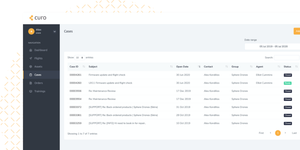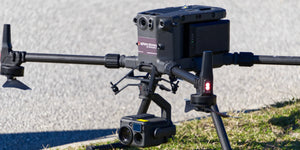There is little question access in and around forest areas is challenging. Large tracts of heavily wooded land has meant traditional monitoring, mapping and surveillance has been time-consuming, extremely costly and often ineffective.
Add to this safety concerns as forestry personnel attempt to access difficult terrain. Indeed, slips, trips and falls are the leading cause of injuries to forest workers in Australia.
Welcome to drone forestry.
At its most basic, being able to fly over hazards is not only safer, but more cost effective and time efficient. Drones are obviously able to cover distances much faster than humans! It has been estimated that using drones in forestry applications is (on average) 300 per cent more productive than a traditional ground surveying crew.
Drones are increasingly being used to capture essential forest data from depth of snow in alpine regions, canopy attributes – such as canopy gaps – and even the extent of carbon storage in a forest area.
From a sustainability perspective, they are conducting aerial surveys of rainforest areas to manage reduction and to determine where trees are being adversely impacted by human activities.
In line with this, communities and companies are using drones to fight deforestation. By using drones to actively monitor forested areas, they can secure images of people or activities that are undertaking illegal deforestation.
Drones are even able to plant trees! In vast and often inaccessible areas, drones can now distribute seedlings in a fast, nimble and efficient manner to ensure forest longevity.
The drone skill set
So what activities do drones carry out when flying over the forest?
Depending on how the drone and payload have been set up, they can:
- Live stream video
- Take high-resolution colour photography
- Take infrared imagery
- Take thermal Imagery
- Engage LiDAR (Light Distance and Ranging)
These functions allow them to support the following forestry applications.
Management
Information related to canopy cover, tree numbers and volume estimation can be achieved quickly and efficiently with drones. This helps for quick and better decision making.
Canopy
Forest disturbances are generally caused by wind and snow and these have a direct impact forest ‘stands’ and regeneration. Satellite imagery has traditionally been used but has been expensive and often inaccurate given distances. Drones and drone sensing equipment have dramatically changed this.
3D mapping
Drone remote sensing is now used to secure 3D mapping of carbon storage within forests.
Restoration
In Australia, bushfires cause extensive damage to land and soil. Land restoration can take years as it requires extensive land survey and tree planting. Drones are being used to conduct rapid surveys that reduce the cost and time for land restoration.
Planting
Planting trees in large forest areas is not easy. Drones can be used to distribute seedlings in these areas in a fast and efficient manner.
Measuring
Drones are measuring forest stockpiles. Data on the number of logs, amount of sawdust and woodchips can now be easily determined and at a much lower cost.
Fertiliser
Time, access and cost make this one of the most challenging issues faced in forestry. Drone payload equipment can now spread fertiliser over large, inaccessible areas.
Deforestation
Communities and companies are now using drones to fight deforestation. Drones are used for surveillance to capture images of people or activities that are involved in illegal deforestation activities.
Security
Illegal logging is becoming commonplace. Authorities are using drones to monitoring this activity.
Planning
Future forest planning requires current information. Acreage, boundaries, forest stands and wood species can be quickly determined for planning purposes.
Disease
Timely drone imagery of timber pests and disease can literally save a forest.
Bushfires
In addition to being used to monitor for bushfires, drones can also provide invaluable support and indeed save fire crew lives, in the event of a bushfire.
So what drone technology is best for forestry applications?
While there are multiple options, we recommend the following (combined) technology for professional forestry applications.
- Delair DT18 with Mama Bear (Long Range Antenna) and beyond visual line of site (BVLOS) technology
The Delair DT18 is professional, fixed-wing, long-range, monitoring and inspection drone ideal for wide-scale forestry applications. Combined with Delair-Tech Mama Bear Long Range Antenna that offers a remarkable 20km link range and with BVLOS technology – you have a truly professional monitoring package perfect for large scale forestry applications.
First and foremost, LiDAR is an acronym for light detection and ranging. In simple terms it is remote sensing technology that uses the pulse from a laser (part of the payload on your drone) to collect measurements which can then be used to create 3D models and maps of objects and environments.
The Delair DT26X has a dual sensor payload for simultaneous collection of LiDAR and photogrammetry data. This ‘dual’ technology means it can be used in a much wider range of projects, dramatically reducing monitoring costs, safety risks and making it a scalable alternative to manned aircraft for large-area forestry mapping.
The mdLiDAR1000 is a fully integrated system for producing 3D point clouds ideal for large tract forestry applications.
It is an end-to-end LiDAR solution that (very neatly and effectively) combines a drone, a LiDAR payload, and fully integrated software workflow.
Some additional information on the benefits of LiDAR in forestry
Accurate information on the terrain, tree heights and densities is, of course, critical to forest managers. LiDAR is unique in its ability to measure the vertical structure of forest canopies and individual tree crowns. As well as mapping the ground beneath the forest, LiDAR is also able to predict canopy bulk density and canopy base height. Both of these factors can be used for (among other things), canopy fuel capacity for use in fire behaviour models.
Another use of LiDAR is the measurement of peak height to estimate the root expanse. This is a valuable tool for insurers when considering houses in particular areas. Knowing the proximity of trees and invasive species to property, overhead power cables and other infrastructure is a useful tool. LiDAR is also increasingly being used to identify habitat corridor gaps, significantly reducing costs in comparison to large-scale manual surveys.
If you are new to drone technology or simply want to learn more, we highly recommend you speak to a UAV specialist that can advise you on both drone options and the best approach to their commercial use in applications such as forestry.
Sphere Drones is arguably Australia’s leading source of expertise on commercial drone technology solutions in Australia.
Their Sydney-based operation is a state-of-the-art solution development facility with some of the UAV industry’s leading personnel – making it (or their website) a logical first step to learn more about or identify a solution for your commercial needs.



















